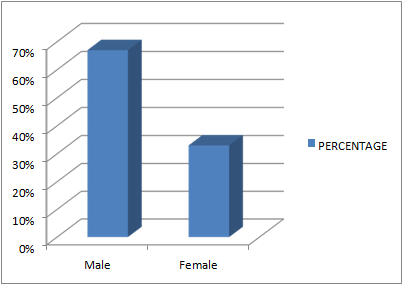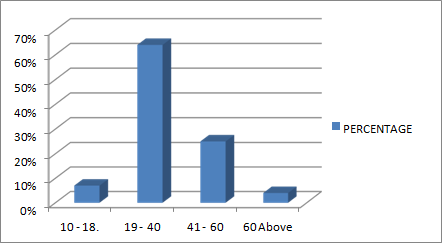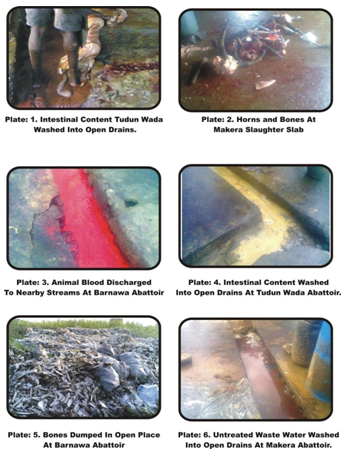IMPROPER MANAGEMENT OF AN ABATTOIR, ITS EFFECT, AND SOLUTION
INTRODUCTION
Background of Study
Abattoir is derived from the French name which is commonly known as a slaughterhouse in the United States and much of the English speaking world. A slaughterhouse is a place where animals are butchered for food; it is very unpleasant but necessary because of our modem human food chain is connected with it.
Through criticism of slaughterhouse do arises from time to time. Slaughterhouse is tightly regulated by the government today, but this was not always the case… (Scroll down for the link to get the Complete Chapter One to Five Project Material)
Statement of the Problem
Obviously, the level of maintenance of hygiene in an abattoir is very poor. Improper management and non-health education were being given to abattoir workers on the importance of good hygiene practices. A worker with rough hands and legs go to the slaughterhouse to slaughter meat. The implication of this is the spread of disease to man.
During these processes, the meat gets contaminated by meat handlers. There was a blockage in some parts of the drains, within the abattoir, and this will form the breeding ground for flies, rats, and other germs found in the environment… (Scroll down for the link to get the Complete Chapter One to Five Project Material)
Research Objectives
The objectives of this study include the following ways;
- To identify those factors which contribute to improper management of an abattoir.
- To assess the level of personal hygiene practices among workers… (Scroll down for the link to get the Complete Chapter One to Five Project Material)
Significance of the Study
It is the researchers hope that the findings of this project will bring about better attention to workers in this abattoir and other related occupations.
This study will also help to intensify the action of safety officers towards adequate health education at all stages of the production processes the improvement of working standards through organized control of those factors in our working environment which tends to exercise deleterious effect on man’s physical development, health, and survival… (Scroll down for the link to get the Complete Chapter One to Five Project Material)

LITERATURE REVIEW
Definition of Waste
Waste can be defined to include any solid material or material that is suspended, dissolved, and transported in water (including sediments and which is spilled or deposited on land or into water resource) in such volume, composition or manner as to cause or to be reasonably likely to cause the water sources to be polluted.
Adedipe (2002) defines waste as any matter, whether gaseous, liquid, or solid or combination which is from time to time designated by the Minister by notice in the gazette as any undesirable or superfluous by-product, emission, residue or remainder of any process or activity… (Scroll down for the link to get the Complete Chapter One to Five Project Material)
Abattoirs
A definition from Colombia Encyclopedia 2014, asserts that an abattoir is a building for butchering that houses facilities to slaughter animals, dress, and cut and inspect meat and refrigerating, and manufactured by-products. The largest abattoirs are those of the meat packaging industry. Abattoirs are also called slaughters houses.
This definition gives a clear indication of the activities that are taking place in the abattoirs or slaughters houses. Abattoirs are usually under regulation by the government, and the government has the right to provide the place with all the facilities needed for the slaughtering of animals, their inspection, and the processing of meat… (Scroll down for the link to get the Complete Chapter One to Five Project Material)
Abattoir Based Pollutants
Rotich et al. (2006) state that slaughterhouse is major polluters to the environment and especially rivers due to the release of effluents. Wastes include paunch, blood, hair, bones, hooves, and horns. Abattoir activities provide a highly suspended solid and liquid which consists of pollutants such as animal feces, blood, fat, animal trimming, paunch content, and urine. Abattoirs wastes are divided into two types, which include the following:
Solid waste that is provided during abattoirs operations is the carcass of dead animals, part of animals which are treated as inedible bones, hoofs, horns, hides, and skin, etc. these are the waste produced from the slaughtered animals. Other sources of solid wastes in the abattoirs are animals holding area, slaughterhouses and processing, waste treatment plants, unwanted hides or slain, and pieces and also unwanted carcasses and carcass parts.
Manure is generated in animals holding area; materials not suitable for rendering, such as unwanted carcasses come from the processing area along with paper cardboard and plastic e.t.c. while the Liquid waste found in abattoirs are mainly blood and wastewater… (Scroll down for the link to get the Complete Chapter One to Five Project Material)
- Animal blood
Animal blood is known to possess high oxygen demand. Blood from beef cattle has a biochemical oxygen demand of 156,500mg/l and chemical oxygen demand of 218,300mg/l. The implication of this fact is that discharge of animal blood into streams would deplete the dissolved oxygen of the aquatic environment (Ezeoha et al, 2011).
- Paunch manure
In ruminants, the first stomach or paunch contains undigested materials or paunch manure. The paunch manure could have a moisture content of about 88% with an average of 177,300mg/l, and an average BOD5 of 50,200mg/l. The solid portion of the paunch manure contains the greatest pollution load, about 73% of the COD, and 40% of the BOD.
Improper disposal of paunch manure can, therefore, exert oxygen demand on the receiving environment or breed a large population of decomposers (micro-organism) some of which may be pathogenic (Onunkwo et al, 2011)… (Scroll down for the link to get the Complete Chapter One to Five Project Material)
Waste Management in Abattoirs
Waste management involves managing activities associated with the generation, collection, transport, and disposal of waste in an environment (Anjaneyulu, 2008). Waste materials are always produced as a result of human industrial and domestic activities. Waste can also be produced by natural causes, at the same time, there has been an increase in product marketing to promote consumption (Digby, 1996).
The activities in the abattoir which consist of holding, inspection, slaughtering, and meat processing in the metropolis has resulted in indiscriminate dumping and disposal of the waste generated from these animals in both solid and liquid forms becomes a major concern on how to manage them (Adeyemo et al, 2007)… (Scroll down for the link to get the Complete Chapter One to Five Project Material)
Environmental Health Implication of Waste Generated In Abattoirs
Sangodoyin et al. (1992) report that the groundwater quality in the vicinity of the abattoirs was adversely affected by the seepage of abattoir effluents as well as water quality of receiving a stream that was located away from the abattoirs.
The health of the dweller is affected by the environment. In every neighborhood, there is a considerable range of biological and chemical pollutants that cause or contribute to diseases. Some may pose health risks for a particular group while others for the entire neighborhood.
UNEP (1996) also reports that waste that is not properly managed especially excreta and other liquid and solid waste from abattoirs and communities are of serious health hazard and leads to the spread of infectious diseases. Unattended waste lying around attracts flies, rats, and other creatures that in turn spread diseases… (Scroll down for the link to get the Complete Chapter One to Five Project Material)
RESEARCH METHODOLOGY
Methods
Primary sources of data will be used in addressing the working objectives of the study through the following means: Reconnaissance survey, field measurements, and questionnaire administration.
Data Collection
Data will be collected through the following method:
- Personal Observation:
Data will be collected from personal observations in the abattoirs as it concerns their routine activities which include: the generation of wastes from the slaughter slab, waste management practices, type of wastes generated, etc.
- Laboratory Analysis:
Laboratory analysis will be conducted on water, where samples will be collected across the study area and subject them to laboratory tests and analysis. Stratified random sampling will be adopted in collecting the samples as follows:
Water samples will be collected from four points along the stream that drains the abattoir for laboratory analysis. The first point will be at about 500m upstream before the abattoir, which will serve as the control sample point; the second point at the entrance of the abattoir effluent into the stream, the remaining two points will be at points down the river.
All the points were at intervals of 500m. The following parameters will be investigated in the water samples which include Microbial Content, PH, Color, Odour, BOD and Test… (Scroll down for the link to get the Complete Chapter One to Five Project Material)

RESEARCH FINDINGS AND DISCUSSION
Personal Data of Respondents
- Sex Distribution
Table 4.2 Sex Distribution
| S/N | Sex | Number of Respondents | Percentage |
| 1. | Male | 239 | 67% |
| 2. | Female | 119 | 33% |
| Total = 358 | Total = 100% |
Source: Field Work, 2014

Fig. 4.2. Sex Distribution
- Age Distribution
Table 4.3 Age Distribution
| S/N | Age | Number of Respondent | Percentage |
| 1. | 10 – 18 | 24 | 7% |
| 2. | 19 – 40 | 230 | 64% |
| 3. | 41 – 60 | 88 | 25% |
| 4. | 60 above | 16 | 4% |
| Total = 358 | Total = 100% |
Source: Field Work, 2014

Fig. 4.3. Age Distribution
(Scroll down for the link to get the Complete Chapter One to Five Project Material)
List of Plates

(Scroll down for the link to get the Complete Chapter One to Five Project Material)
Conclusion and Recommendations
- Conclusion
From the study, it is observed that all the abattoirs generate a significant amount of wastes which include Wastewater, animal blood, urine, Carcass, bones, hoofs, animal feces, hides, and skin, and intestinal contents (i.e. solid and liquid). And also the burning of skins, bones also constitute serious health hazards as it poses difficulty in breathing, and other Lung related cancer.
Based on the finding it is obvious that these wastes have a profound impact on the quality of the water within the vicinity of the abattoirs. Moreover, the presence of microorganisms has been confirmed in all the selected abattoirs; as their presence potent serious public health hazard, and also their presence is associated with water-borne diseases since the waste is discharged into the streams… (Scroll down for the link to get the Complete Chapter One to Five Project Material)
Recommendation
The water quality was generally below the recommended standards, it is however under threat if the present habit of discharging untreated abattoir wastes continues. Residents living within the abattoir vicinity may in no distant time begin to experience severe consequences of pollutants from abattoir activities located in their neighborhood.
The majority of the households depends on shallow well water for domestic use, and effluent may leach into the groundwater table in the rainy season. In view of the findings of this work, and in addition to the fact that the abattoir is located in the heart of the town, and also, in view of the fact that the discharge of untreated abattoir wastes may continue unabated, the following recommendations are hereby made:
- The government should provide adequate waste disposal facilities to cater to both solid and liquid waste… (Scroll down for the link to get the Complete Chapter One to Five Project Material)

REFERENCE
Abattoir Acts 1988. Http//www.Irishstatutebook.i.e/1988/en/act/pub/0008/index. Html. (Retrieved 13/06/ 2014)
Abdulmalik M. S. (2009). Wastes Management Practices in Selected Abattoirs a Case Study of Katsina LGA of Katsina State, unpublished.
Adedipe, N. O. (2002) ‘Challenges of Urban Solid Waste Management in Africa’ in: Baijnath H. and Singh Y. (Eds), Rebirth of Science in Africa (Hatfield, South Africa, Hundaus Press) pp. 175-192
Adeyemo, O. et al. (2009). Cattle cruelty and risks of meat contamination at Akinyele cattle market and slaughter slab in Oyo State, Nigeria, Tropical Animal Health and Production 41, 1715- 1721.
Adesemoye, et al. (2006) Microbial Content of Abattoir Waste and its Contaminated Soil in Lagos, Nigeria. Http//:www.academicjounals. org/ABJ/PDF/…/ Adesemoye %20et%20al.pdf. (Retrieved 7/09/2014).
Adeyemo, O.K., et al. (2002). The effect of graded levels of poultry offal in the diet of Clarias gariepinus. Trop. Vet., 20(2), 62-67.
Ayodeji, I. O. et al. (2002) African journal of biomedical research, vol. 5, no. 1-2, Jan & May, 2002 pp. 51-55.
Aina, E.O.A. and Adedipe, N.O. (1991), Water Quality Monitoring and Environmental status in Nigeria. FEPA Monograph, Lagos, pp12-59. (slaughterhouse)(slaughterhouse)(slaughterhouse)(slaughterhouse)
Akinro, et al. (2009) Environmental Implications of Unhygienic Operation of a City Abattoir in Akure, Western Nigeria; ARPN Journal of Engineering and Applied Sciences 4, 311-315. (slaughterhouse)(slaughterhouse)
Alonge, D. O. (1991) Meat Hygiene in the Tropics. Farmcoe Press, Ibadan, Nigeria 58pp. (slaughterhouse)(slaughterhouse)(slaughterhouse)(slaughterhouse)(slaughterhouse)(slaughterhouse)(slaughterhouse)
Anjaneyulu, Y. (2006). Introduction to Environmental Science, Solid Waste Management. Sultan Bazar: Bs Publishers, Ibadan, Nigeria. (slaughterhouse)(slaughterhouse)(slaughterhouse)(slaughterhouse)(slaughterhouse)
Baker, J. (1999) ‘Progress Towards No Waste By 2010’: A Report by the Commissioner for Environment, Act on the implementation of the Act Government No Waste by 2010 Strategy (Canberra Australia Act) pp. 87.
Bello, et al. (2009) Impact of Abattoir Activities and Management in Residential Neighbourhoods A case study of Ogbomoso, Nigeria; Journal of Social Science 19, 121-127. (slaughterhouse)(slaughterhouse)(slaughterhouse)
(Scroll down for the link to get the Complete Chapter One to Five Project Material)
